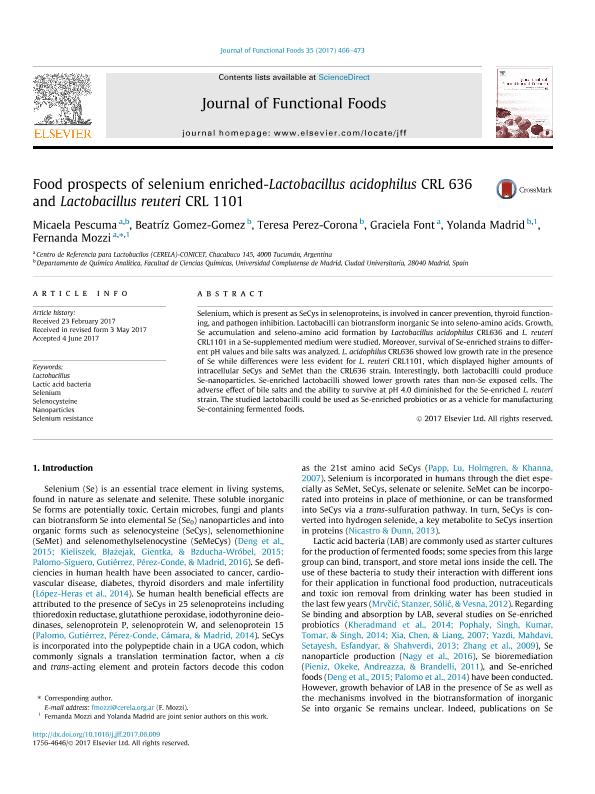Artículo
Food prospects of selenium enriched-Lactobacillus acidophilus CRL 636 and Lactobacillus reuteri CRL 1101
Pescuma, Micaela ; Gomez Gomez, Beatríz; Perez Corona, Teresa; Font, Graciela Maria
; Gomez Gomez, Beatríz; Perez Corona, Teresa; Font, Graciela Maria ; Madrid Albarrn, Yolanda; Mozzi, Fernanda Beatriz
; Madrid Albarrn, Yolanda; Mozzi, Fernanda Beatriz
 ; Gomez Gomez, Beatríz; Perez Corona, Teresa; Font, Graciela Maria
; Gomez Gomez, Beatríz; Perez Corona, Teresa; Font, Graciela Maria ; Madrid Albarrn, Yolanda; Mozzi, Fernanda Beatriz
; Madrid Albarrn, Yolanda; Mozzi, Fernanda Beatriz
Fecha de publicación:
08/2017
Editorial:
Elsevier Ltd
Revista:
Journal of Functional Foods
ISSN:
1756-4646
Idioma:
Inglés
Tipo de recurso:
Artículo publicado
Clasificación temática:
Resumen
Selenium, which is present as SeCys in selenoproteins, is involved in cancer prevention, thyroid functioning, and pathogen inhibition. Lactobacilli can biotransform inorganic Se into seleno-amino acids. Growth, Se accumulation and seleno-amino acid formation by Lactobacillus acidophilus CRL636 and L. reuteri CRL1101 in a Se-supplemented medium were studied. Moreover, survival of Se-enriched strains to different pH values and bile salts was analyzed. L. acidophilus CRL636 showed low growth rate in the presence of Se while differences were less evident for L. reuteri CRL1101, which displayed higher amounts of intracellular SeCys and SeMet than the CRL636 strain. Interestingly, both lactobacilli could produce Se-nanoparticles. Se-enriched lactobacilli showed lower growth rates than non-Se exposed cells. The adverse effect of bile salts and the ability to survive at pH 4.0 diminished for the Se-enriched L. reuteri strain. The studied lactobacilli could be used as Se-enriched probiotics or as a vehicle for manufacturing Se-containing fermented foods.
Archivos asociados
Licencia
Identificadores
Colecciones
Articulos(CERELA)
Articulos de CENTRO DE REFERENCIA PARA LACTOBACILOS (I)
Articulos de CENTRO DE REFERENCIA PARA LACTOBACILOS (I)
Citación
Pescuma, Micaela; Gomez Gomez, Beatríz; Perez Corona, Teresa; Font, Graciela Maria; Madrid Albarrn, Yolanda; et al.; Food prospects of selenium enriched-Lactobacillus acidophilus CRL 636 and Lactobacillus reuteri CRL 1101; Elsevier Ltd; Journal of Functional Foods; 35; 8-2017; 466-473
Compartir
Altmétricas



